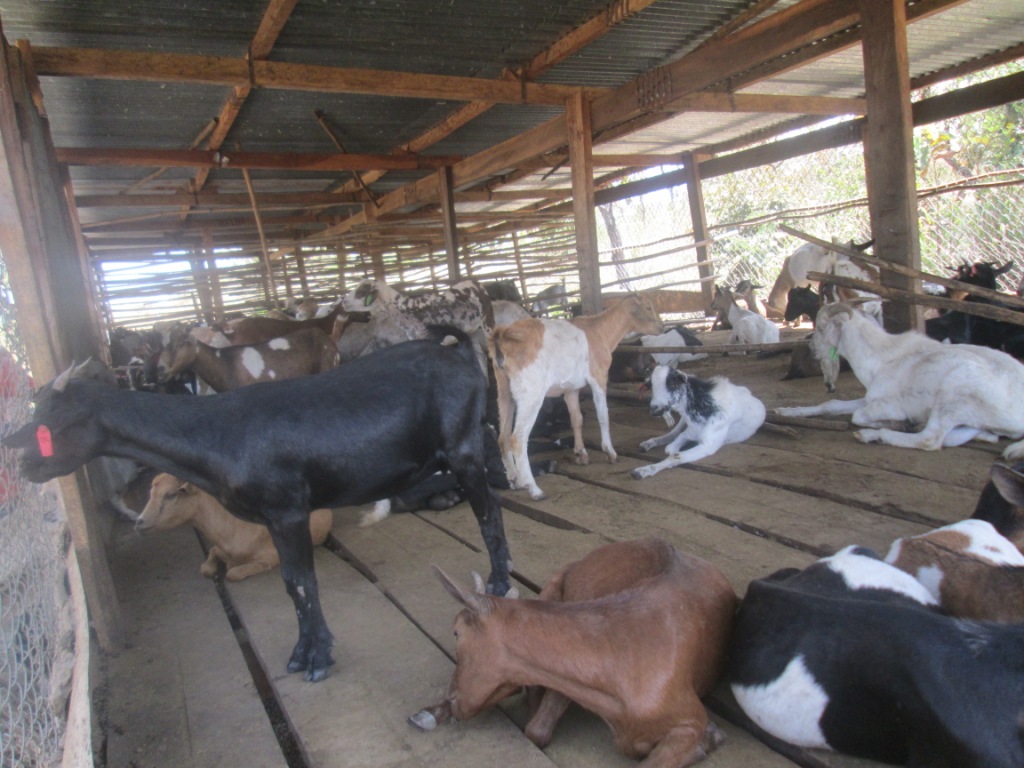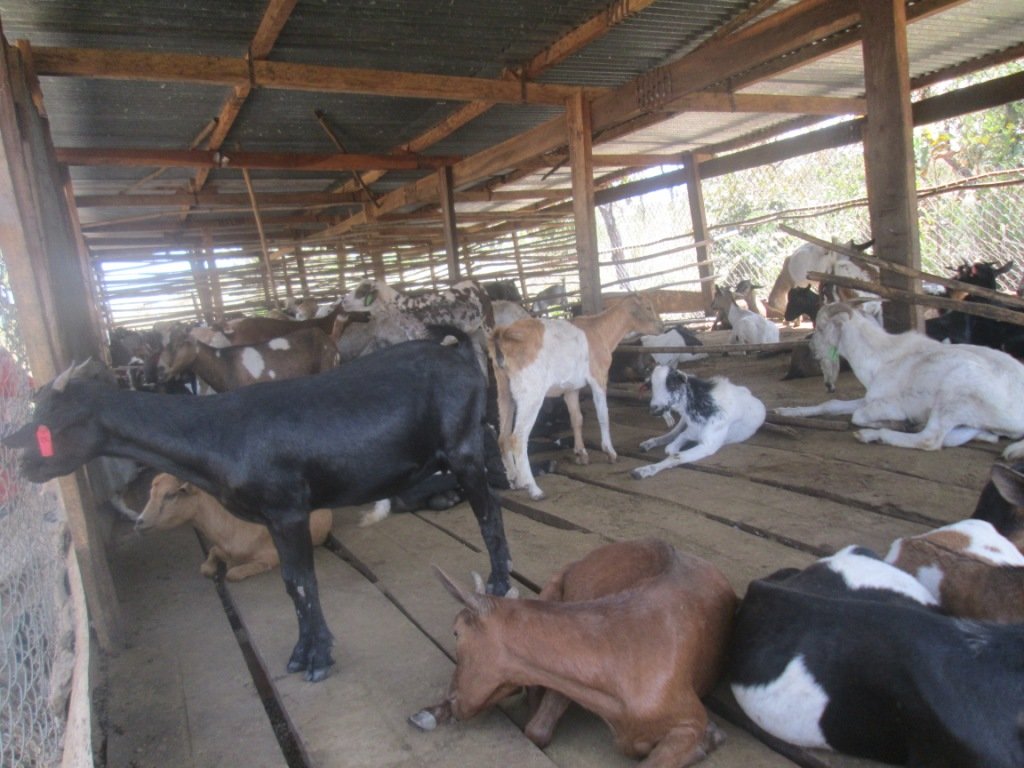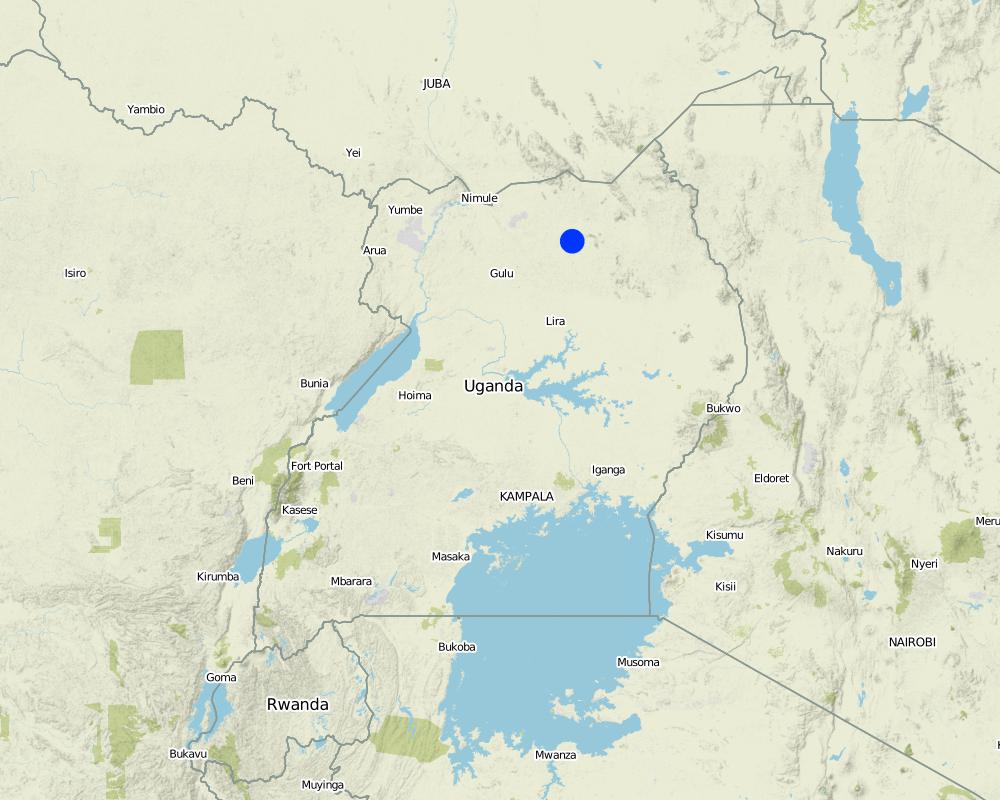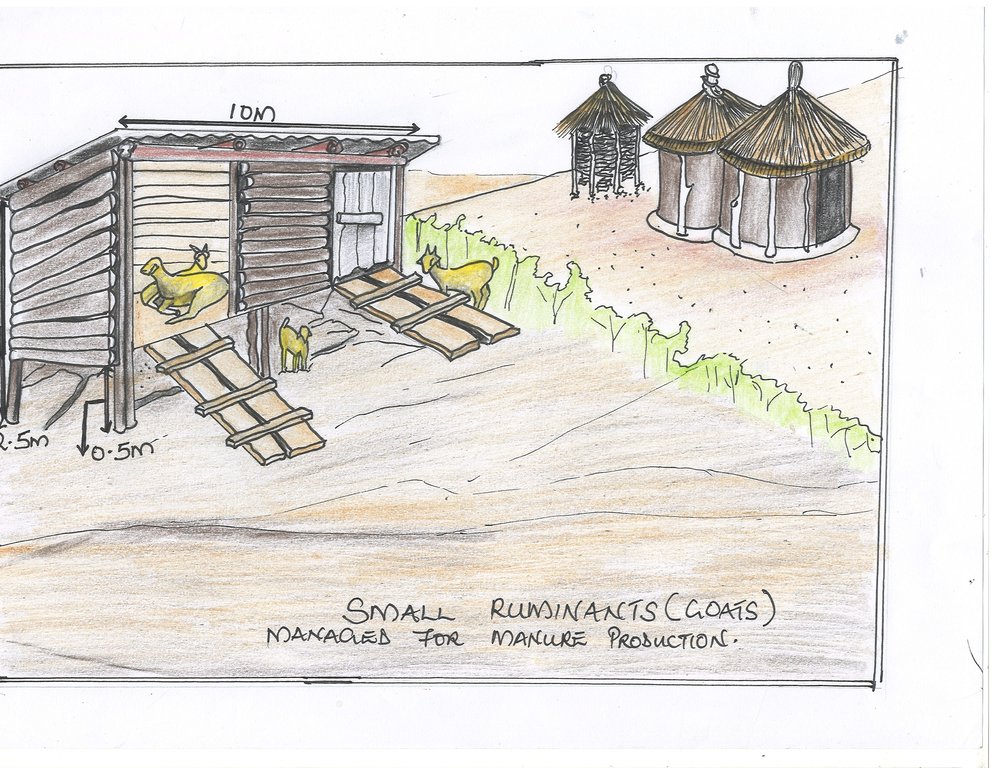Small ruminant management for manure production (goats) [乌干达]
- 创建:
- 更新:
- 编制者: Kamugisha Rick Nelson
- 编辑者: JOY TUKAHIRWA, Richard Otto Kawawa, Sunday Balla Amale, Bernard Fungo
- 审查者: John Stephen Tenywa, Nicole Harari, Renate Fleiner, Stephanie Jaquet, Donia Mühlematter
Gwooko dyel pi kelo moc cam
technologies_2784 - 乌干达
查看章节
全部展开 全部收起1. 一般信息
1.2 参与该技术评估和文件编制的资源人员和机构的联系方式
关键资源人
土地使用者:
Nyeko Alex
0789780517
Laber Farm holdings
Bollo village
乌干达
有助于对技术进行记录/评估的项目名称(如相关)
Scaling-up SLM practices by smallholder farmers (IFAD)有助于对技术进行记录/评估的机构名称(如相关)
CDE Centre for Development and Environment (CDE Centre for Development and Environment) - 瑞士1.3 关于使用通过WOCAT记录的数据的条件
(现场)数据是什么时候汇编的?:
11/05/2017
编制者和关键资源人员接受有关使用通过WOCAT记录数据的条件。:
是
1.4 所述技术的可持续性声明
这里所描述的技术在土地退化方面是否存在问题,导致无法被认为是一种可持续的土地管理技术?:
否
注释:
Local breed goats housed in a goat shed produce manure for annual and perennial cropland.
2. SLM技术的说明
2.1 技术简介
技术定义:
Local goat breeds housed in a shed to generate manure for annual and perennial cropland.
2.2 技术的详细说明
说明:
Small ruminants (goats) produce significant quantities of nutrient rich manure, which is useful for replenishing soil fertility for crop production. In Northern Uganda, this technology involves several goats, raised in a shade constructed often of wooden materials. An average shade covers about 10 m by 2.5 m, and raised up to 0.5 m off the ground to protect the ruminants from vermin such as snakes and rats, as well as rainwater flooding. The ground floor may be cemented so that the droppings are kept free from mixing with other pesticides and various chemicals used to control external parasites that may contaminate the manure. The droppings generated by the animals are collected from underneath the shade and heaped in a pit for composting. The pit is covered for about two weeks using a grass and soil or polythene paper. After this period, the compost manure is mature and is ready for application in the fields to increase production. Because this technology involves goats, it is relatively easier and cheaper to maintain than the case of cattle in terms of feeding and maintenance. Besides, it is more efficient in providing manure for soil fertility improvement since the droppings generated by the animals are collected from underneath the shade and heaped in a pit for composting and collected over time. Moreover, the demand for goat meat is often high, thus its price remains steadily high during the year. To be able to manage this technology and to achieve desired benefits, the farmer must keep in contact with the extension worker for veterinary services because goat diseases are rampant in the region and vary from simple skin ailments, diarrhoea to severe conditions causing, loss of weight, abortion and death. The most common infections include; Scours that are more common in young goats and dirty pens caused by bacteria, coccidia, worms or even showing the following signs; loss of appetite, diarrhoea (yellow to red discoloration), pasting of faeces under and around the tail, loss of weight and high temperature. Goats are well known for their strength and resilience to diseases. However, this does not necessarily mean that they are never affected. This often accounts for a substantial part of the cost of production.
2.3 技术照片
2.4 技术视频
注释、简短说明:
Video showing small ruminant management for manure production (goats)
日期:
09/05/2017
位置:
Kitgum District
摄影师的名字:
Issa Aliga
2.5 已应用该技术的、本评估所涵盖的国家/地区/地点
国家:
乌干达
区域/州/省:
Western Uganda Region
有关地点的进一步说明:
Town
Map
×2.6 实施日期
注明实施年份:
2015
如果不知道确切的年份,请说明大概的日期:
- 不到10年前(最近)
2.7 技术介绍
详细说明该技术是如何引入的:
- 通过土地使用者的创新
3. SLM技术的分类
3.1 该技术的主要目的
- 改良生产
- 减少、预防、恢复土地退化
- 保护生态系统
- 创造有益的经济影响
3.2 应用该技术的当前土地利用类型

农田
- 一年一作
主要农作物(经济作物及粮食作物):
Maize.

牧场
集约放牧/饲料生产:
- 收割和携带/零放牧
主要动物种类及产品:
Goats and sheep.
3.3 有关土地利用的更多信息
该技术所应用土地的供水:
- 雨养
每年的生长季节数:
- 2
牲畜密度(如相关):
20 goats and 16 sheep.
3.4 该技术所属的SLM组
- 农畜综合管理
- 土壤肥力综合管理
3.5 技术传播
具体说明该技术的分布:
- 适用于特定场所/集中在较小区域
3.6 包含该技术的可持续土地管理措施

农艺措施
- A3:土壤表面处理

结构措施
- S9:动植物庇护所

管理措施
- M6:废物管理(回收、再利用或减少)
注释:
M6 (composting)
3.7 该技术强调的主要土地退化类型

化学性土壤退化
- Cn:肥力下降和有机质含量下降(非侵蚀所致)
- Ca:酸化

物理性土壤退化
- Ps:有机土壤沉降,土壤沉降

生物性退化
- Bq:数量/生物量减少
- Bl:土壤寿命损失
3.8 防止、减少或恢复土地退化
具体数量名该技术与土地退化有关的目标:
- 防止土地退化
- 减少土地退化
4. 技术规范、实施活动、投入和成本
4.1 该技术的技术图纸
4.2 技术规范/技术图纸说明
Approximately 2-2.5 m high, 10 m long and 2.5 m wide. Made by wooden materials with iron sheets on top.
Capacity: 40-70 ruminants.
4.3 有关投入和成本计算的一般信息
具体说明成本和投入是如何计算的:
- 每个技术区域
注明尺寸和面积单位:
Less than 0.5 acres
其它/国家货币(具体说明):
UGX
注明美元与当地货币的汇率(如相关):1美元=:
3500.0
注明雇用劳工的每日平均工资成本:
5000 per person per day
4.4 技术建立活动
| 活动 | 措施类型 | 时间 | |
|---|---|---|---|
| 1. | Drawing structural plan | 结构性的 | Once before establishment |
| 2. | Purchasing and assembling material | 管理 | once before estabslishment |
| 3. | Measuring and laying out plan/pitting | 结构性的 | Once during establishment |
| 4. | Contsruction of the struture | 结构性的 | During establishment |
| 5. | Manure collection and composting | 管理 | Routine |
4.5 技术建立所需要的费用和投入
| 对投入进行具体说明 | 单位 | 数量 | 单位成本 | 每项投入的总成本 | 土地使用者承担的成本% | |
|---|---|---|---|---|---|---|
| 劳动力 | Labour for construction on daily basis | persons | 3.0 | 5000.0 | 15000.0 | 100.0 |
| 施工材料 | poles | Pieces | 20.0 | 3000.0 | 60000.0 | 100.0 |
| 施工材料 | iron sheets | Pieces | 5.0 | 20000.0 | 100000.0 | 100.0 |
| 施工材料 | Nails | kgs | 5.0 | 3000.0 | 15000.0 | 100.0 |
| 施工材料 | wire mesh | kgs | 20.0 | 50000.0 | 1000000.0 | 100.0 |
| 技术建立所需总成本 | 1190000.0 | |||||
4.6 维护/经常性活动
| 活动 | 措施类型 | 时间/频率 | |
|---|---|---|---|
| 1. | Manure collection and composting | 管理 | daily |
| 2. | Manure application to gardens | 管理 | monthly |
4.7 维护/经常性活动所需要的费用和投入(每年)
| 对投入进行具体说明 | 单位 | 数量 | 单位成本 | 每项投入的总成本 | 土地使用者承担的成本% | |
|---|---|---|---|---|---|---|
| 劳动力 | labour on daily basis | persons | 3.0 | 5000.0 | 15000.0 | 100.0 |
| 技术维护所需总成本 | 15000.0 | |||||
注释:
All the costs are covered by the land user.
4.8 影响成本的最重要因素
描述影响成本的最决定性因素:
Labour takes most of the costs.
5. 自然和人文环境
5.1 气候
年降雨量
- < 250毫米
- 251-500毫米
- 501-750毫米
- 751-1,000毫米
- 1,001-1,500毫米
- 1,501-2,000毫米
- 2,001-3,000毫米
- 3,001-4,000毫米
- > 4,000毫米
指定年平均降雨量(若已知),单位为mm:
1400.00
农业气候带
- 半湿润
5.2 地形
平均坡度:
- 水平(0-2%)
- 缓降(3-5%)
- 平缓(6-10%)
- 滚坡(11-15%)
- 崎岖(16-30%)
- 陡峭(31-60%)
- 非常陡峭(>60%)
地形:
- 高原/平原
- 山脊
- 山坡
- 山地斜坡
- 麓坡
- 谷底
垂直分布带:
- 0-100 m a.s.l.
- 101-500 m a.s.l.
- 501-1,000 m a.s.l.
- 1,001-1,500 m a.s.l.
- 1,501-2,000 m a.s.l.
- 2,001-2,500 m a.s.l.
- 2,501-3,000 m a.s.l.
- 3,001-4,000 m a.s.l.
- > 4,000 m a.s.l.
说明该技术是否专门应用于:
- 不相关
5.3 土壤
平均土层深度:
- 非常浅(0-20厘米)
- 浅(21-50厘米)
- 中等深度(51-80厘米)
- 深(81-120厘米)
- 非常深(> 120厘米)
土壤质地(表土):
- 中粒(壤土、粉土)
土壤质地(地表以下> 20厘米):
- 中粒(壤土、粉土)
表土有机质:
- 低(<1%)
5.4 水资源可用性和质量
地下水位表:
5-50米
地表水的可用性:
好
水质(未处理):
良好饮用水
水的盐度有问题吗?:
否
该区域正在发生洪水吗?:
是
规律性:
偶然
5.5 生物多样性
物种多样性:
- 中等
栖息地多样性:
- 中等
5.6 应用该技术的土地使用者的特征
定栖或游牧:
- 定栖的
生产系统的市场定位:
- 混合(生计/商业
非农收入:
- 收入的10-50%
相对财富水平:
- 贫瘠
个人或集体:
- 个人/家庭
机械化水平:
- 手工作业
性别:
- 男人
土地使用者的年龄:
- 中年人
5.7 应用该技术的土地使用者拥有或租用的平均土地面积
- < 0.5 公顷
- 0.5-1 公顷
- 1-2 公顷
- 2-5公顷
- 5-15公顷
- 15-50公顷
- 50-100公顷
- 100-500公顷
- 500-1,000公顷
- 1,000-10,000公顷
- > 10,000公顷
这被认为是小规模、中规模还是大规模的(参照当地实际情况)?:
- 小规模的
5.8 土地所有权、土地使用权和水使用权
土地所有权:
- 个人,未命名
土地使用权:
- 个人
用水权:
- 社区(有组织)
5.9 进入服务和基础设施的通道
健康:
- 贫瘠
- 适度的
- 好
教育:
- 贫瘠
- 适度的
- 好
技术援助:
- 贫瘠
- 适度的
- 好
就业(例如非农):
- 贫瘠
- 适度的
- 好
市场:
- 贫瘠
- 适度的
- 好
能源:
- 贫瘠
- 适度的
- 好
道路和交通:
- 贫瘠
- 适度的
- 好
饮用水和卫生设施:
- 贫瘠
- 适度的
- 好
金融服务:
- 贫瘠
- 适度的
- 好
6. 影响和结论性说明
6.1 该技术的现场影响
社会经济效应
生产
作物生产
注释/具体说明:
Due to application of manure.
收入和成本
农业收入
注释/具体说明:
Income increased from the sale of goats and the sale of maize.
收入来源的多样性
注释/具体说明:
From goats, sheep, and maize.
生态影响
土壤
土壤有机物/地下C
注释/具体说明:
Due to application of animal manure.
6.2 该技术的场外影响已经显现
对邻近农田的破坏
注释/具体说明:
Due to controlled grazing.
6.3 技术对渐变气候以及与气候相关的极端情况/灾害的暴露和敏感性(土地使用者认为的极端情况/灾害)
渐变气候
渐变气候
| 季节 | 气候变化/极端天气的类型 | 该技术是如何应对的? | |
|---|---|---|---|
| 年降雨量 | 减少 | 适度 |
气候有关的极端情况(灾害)
生物灾害
| 该技术是如何应对的? | |
|---|---|
| 流行病 | 适度 |
6.4 成本效益分析
技术收益与技术建立成本相比如何(从土地使用者的角度看)?
短期回报:
消极
长期回报:
积极
技术收益与技术维护成本/经常性成本相比如何(从土地使用者的角度看)?
短期回报:
中性/平衡
长期回报:
积极
注释:
Balanced at the time of establishment and positive within 1-2 years and more.
6.5 技术采用
- 单例/实验
在所有采用这项技术的人当中,有多少人是自发地采用该技术,即未获得任何物质奖励/付款?:
- 10-50%
6.6 适应
最近是否对该技术进行了修改以适应不断变化的条件?:
否
6.7 该技术的优点/长处/机会
| 土地使用者眼中的长处/优势/机会 |
|---|
| Relatively cheap because it uses locally available materials and labour. |
| Does not require expensive maintenance costs in terms of labour. |
| Special skills are required for management and maintenance. The land user can even use family labour. |
| 编制者或其他关键资源人员认为的长处/优势/机会 |
|---|
| Goats are on demand and income is guaranteed once the farmer has his ruminants ready for sale each goes to 100,000-200,000 UGX equivalent to 26.5- 57 Unites states dollars depending on the size. |
| Small ruminant manure is good at improving soil fertility and is nutritious and increase crop yields significantly. |
| Small ruminant requires medical/ veterinary attention which are readily available at sub-county level. |
6.8 技术的弱点/缺点/风险及其克服方法
| 土地使用者认为的弱点/缺点/风险 | 如何克服它们? |
|---|---|
| Susceptible to thieves. | Provide security to guard against thieves. |
| 编制者或其他关键资源人员认为的弱点/缺点/风险 | 如何克服它们? |
|---|---|
| The technology is susceptible to diseases if not managed well. This may result to deaths. | Attend to the technology on a daily basis by cleaning the house shade and treating diseases. |
7. 参考和链接
7.1 信息的方法/来源
- 实地考察、实地调查
01
- 与土地使用者的访谈
01
链接和模块
全部展开 全部收起链接
无链接
模块
无模块







